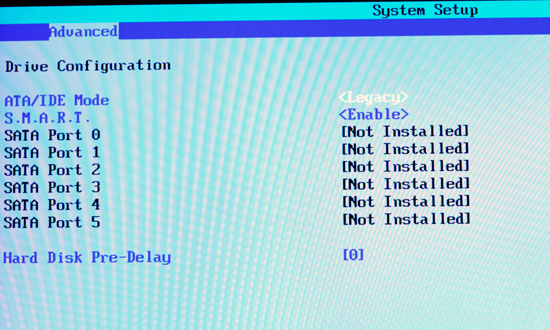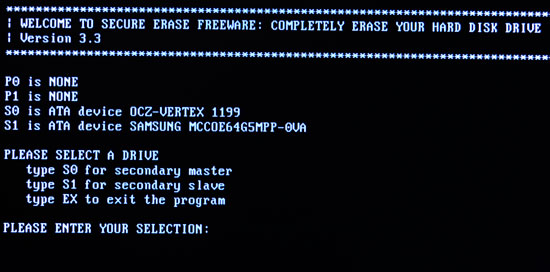The SSD Anthology: Understanding SSDs and New Drives from OCZ
by Anand Lal Shimpi on March 18, 2009 12:00 AM EST- Posted in
- Storage
Restoring Your Drive to Peak Performance
Based on my explanation there’s one sure-fire way to make your drive fast again. Formatting/deleting everything on the drive won’t work because those pages on the drive will remain full of data.
If you are doing a clean setup of your machine and want to restore your drive to its native state you’ll have to perform a secure erase. Intel distributed a tool with the first X25-M review kits called HDD ERASE. This tool will take any SSD and free every last page on the drive. Obviously you’ll lose all of your data but your drive will be super fast again!
In order for HDDERASE to work you need to have your SATA controller running in Legacy IDE mode, you can select this in your BIOS. Your drive will have to be connected to one of the first four SATA ports off of the controller.

Boot to a command prompt (I just use a bootable DOS image on my USB stick) and run the executable. Answer its questions carefully and with honor.



Tell it you would like to perform a secure erase (an extended one isn’t necessary) and when it asks you if you wish to view LBA 0 you can say no. Reboot your machine (don’t forget to set your SATA controller back to whatever mode you had it in before, e.g. RAID or AHCI), partition your drive and you’re back in business.
On a good SSD I don’t believe there’s a need to secure erase periodically, but whenever you format or re-image your drive, I’d recommend a secure erase since you’re killing all of your data anyway.










250 Comments
View All Comments
Luddite - Friday, March 20, 2009 - link
So even with the TRIM command, when working with large files, say, in photoshop and saving multiple layers, the performance will stil drop off?proviewIT - Thursday, March 19, 2009 - link
I bought a Vertex 120GB and it is NOT working on my Nvidia chipsets motherboard. Anyone met the same problem? I tried intel chipsets motherboard and seems ok.I used HDtach to test the read/write performance 4 days ago, wow, it was amazing. 160MB/s in write. But today I felt it slower and used HDtach to test again, it downs to single digit MB per second. Can I recover it or I need to return it?
kmmatney - Thursday, March 19, 2009 - link
Based on the results and price, I would say that the OCZ Vertex deserves a Editor's choice of some sort (Gold, Silver)...Tattered87 - Thursday, March 19, 2009 - link
While I must admit I skipped over some of the more technical bits where SSD was explained in detail, I read the summaries and I've gotta admit this article was extremely helpful. I've been wanting to get one of these for a long time now but they've seemed too infantile in technological terms to put such a hefty investment in, until now.After reading about OCZ's response to you and how they've stepped it up and are willing to cut unimportant statistics in favor of lower latencies, I actually decided to purchase one myself. Figured I might as well show my appreciation to OCZ by grabbing up a 60GB SSD, not to mention it looks like it's by far the best purchase I can make SSD-wise for $200.
Thanks for the awesome article, was a fun read, that's for sure.
bsoft16384 - Thursday, March 19, 2009 - link
Anand, I don't want to sound too negative in my comments. While I wouldn't call them unusable, there's no doubt that the random write performance of the JMicron SSDs sucks. I'm glad that you're actually running random I/O tests when so many other websites just run HDTune and call it a day.That X25-M for $340 is looking mighty tempting, though.
MrSpadge - Thursday, March 19, 2009 - link
Hi,first: great article, thanks to Anand and OCZ!
Something crossed my mind when I saw the firmware-based trade-off between random writes and sequential transfer rates: couldn't that be adjusted dynamically to get the best of both worlds? Default to the current behaviour but switch into something resembling te old one when extensive sequential transfers are detected?
Of course this neccesiates that the processor would be able to handle additional load and that the firmware changes don't involve permanent changes in the organization of the data.
Maybe the OCZ-Team already thought about this and maybe nobody's going to read this post, buried deep within the comments..
MrS
Per Hansson - Thursday, March 19, 2009 - link
Great work on the review AnandI really enjoyed reading it and learning from it
Will there be any tests of the old timers like Mtron etc?
tomoyo - Thursday, March 19, 2009 - link
That was kind of strange to me too. But I assume Anand really means the desktop market, not the server storage/business market. Since it's highly doubtful that the general consumer will spend many times as much money for 15k SAS drives.Gary Key - Thursday, March 19, 2009 - link
The intent was based it being the fastest for a consumer based desktop drive, the text has been updated to reflect that fact.tomoyo - Thursday, March 19, 2009 - link
I've always been someone who wants real clarify and truth to the information on the internet. That's a problem because probably 90% of things are not. But Anand is one man I feel a lot of trust for because of great and complete articles such as this. This is truly the first time that I feel like I really understand what goes into ssd performance and why it can be good or bad. Thank you so much for being the most inciteful voice in the hardware community. And keep fighting those damn manufacturers who are scared of the facts getting in the way of their 200MB/s marketing bs.